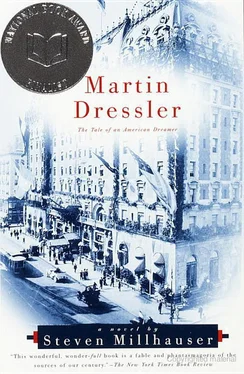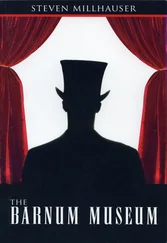In order to satisfy requests for tours of the New Dressler from journalists, prospective long-term residents, and curiosity seekers, Martin organized a staff of female guides in green uniforms with red trim. He himself liked to take people around from time to time, beginning with the roof garden and the seventh underground level, as if to draw a line around his creation. Ascending first to the roof of the New Dressler with its lush landscape of woods and streams, its cave-restaurant set in the side of a wooded hill, its peacocks and tame deer, its water tank and elevator bulkhead cleverly disguised as rustic cottages, he would descend suddenly and dramatically to the labyrinth on the seventh underground level. The labyrinth was a series of winding passages designed to meet the hotel guest’s need for solitude and mystery, where one could wander for hours along dim-lit subterranean paths leading in and out of small rocky chambers supplied with benches. Black streams flowed here and there, a waterfall trickled down a sheer wall, and a number of surprises had been arranged: a narrow opening led to a library with reading lamps and couches, a winding passage went past a replicated Hindu temple, and around one bend appeared a black lake with an island, on which stood a small teahouse reachable by rowboat.
Beneath the labyrinth lay the true bottom of the New Dressler, the bottom beneath the bottom: the basement. It was a dark realm with many subdivisions, including the electric plant with its dynamos, the steam plant with its boilers, the laundry rooms with their boiling tubs and steam dryers, the ironing rooms, the storage rooms, the employee cafeteria, and the workshops for the large maintenance staff of the New Dressler: the painters, the electricians, the seamstresses, the upholsterers, the silver polishers, the carpenters. In the vast underground world of half-darkness and hissing steam, of hammer-knocks and the rumble of dynamos, Martin liked to walk for hours at a time, observing the machines that gave life to the building, watching the work of the repairmen, speaking with the laundresses, their sleeves rolled to the elbow, their forearms glistening, their faces shiny in the damp warm air.
At the end of the day, Martin walked back with Emmeline to meet Caroline and Margaret for dinner at the old Dressler. After dinner all four would take a turn in the underground courtyard, whereupon Caroline, growing tired, would retire to her rooms, and Martin would return to the New Dressler to speak with the night manager and continue his rounds.
Even as he walked through the world of the New Dressler, observing its operation, hovering, brooding over what he had built, Martin had begun to notice an alcove, a secret shadowy alcove, deep in his mind. Here images were slowly taking shape, and one day he met again with Rudolf Arling, in the small office with its view of the Brooklyn tower of the great bridge. Arling listened with interest to Martin’s new idea, which kept assuming slightly different shapes, but the preliminary sketches disappointed Martin: Arling, for all his boldness, was still dreaming of a grand hotel, whereas Martin was trying to make him see something quite different. Then one day Arling simply made a leap, it was as if he had put the old way behind him forever, and now the sketches took on a startling quality, as if Martin were seeing his dream harden into shape before him. And Arling had good news. A recent commission of his, an apartment house with an all-too-familiar Beaux Arts exterior and a barrel-vault porte cochère that led to an interior courtyard, had received such favorable attention in the architectural press that he was suddenly in great demand, a fact that would serve Martin well when he approached the cautious Lellyveld. Martin reported his meetings with the architect to Emmeline after lunch as they walked on secluded paths in the subterranean park of the New Dressler, but Emmeline, who listened thoughtfully, showed signs of distraction. She confessed one afternoon that she was concerned about Caroline, whose behavior had recently taken a disturbing turn.
FOR CAROLINE HAD BEGUN TO WITHDRAW FOR many hours to the sofa in her mother’s parlor, where she lay with an arm thrown over her eyes. This in itself was no special cause for concern, since Caroline had often withdrawn to the family sofa, had in a sense made a career of such withdrawals, while everyone hovered about anxiously and waited for her to return to normal — although in Caroline’s case it might be argued that the normal was precisely this withdrawal to the family sofa. No, what Emmeline found disturbing was Caroline’s reluctance to return to her own bed at night. Margaret practically had to drag her out the door. It was a strain on poor Margaret, who worried continually about the welfare of her daughters, and especially of Caroline, who needed something to occupy her time but who unfortunately had no strong interests. During the reign of Claire Moore, Emmeline had encouraged Caroline’s sudden attraction to the theater, unreasonably hoping that it would survive Claire Moore’s departure. Even as a girl Caroline had had the habit of starting books and never finishing them, losing interest after the first couple of chapters, sometimes reading right up to the last chapter and then abandoning the book forever. It used to upset Emmeline terribly, all those unfinished stories lying around, like dolls with missing arms. And so in time she had come to think that Caroline’s illnesses were her discovery of a way to occupy her time, although this perhaps sounded harsher than she meant it to be. She had thought that marriage — well, she had given her opinion at the time. And now Caroline was reluctant to leave her mother’s parlor at all, she had even hinted that she would like to sleep on the sofa at night.
“Then let her do it,” Martin said irritably. “For a night or two. If you think it will help.”
Emmeline was uncertain, but said that she would discuss it with her mother that very night. The next morning as they walked up Riverside to the New Dressler, Emmeline reported that perhaps it wouldn’t be such a bad thing after all for Caroline to sleep on the sofa, for just a few nights, since it was something she seemed determined to do.
It was quickly arranged. Martin, who at first had been annoyed by yet another of Caroline’s whims, found the new plan oddly agreeable. He no longer had to creep quietly into bed at night, for fear of waking Caroline and giving her a headache, or tiptoe about in the dark of early morning. And Caroline’s absence from the apartment gave his rooms an airiness, a lightness, as if some faint disturbance in the atmosphere had cleared. But more than this, he liked the sense that the three Vernon women were together again, as if by marrying one of them he had somehow harmed the group. After dinner, walking with Caroline and Emmeline and Margaret in the underground courtyard of the Dressler, he was reminded of earlier days, when he had returned to the Bellingham and seen the three Vernon women waiting for him at the lamplit table in the parlor off the main lobby. And glancing at Caroline, who still wore her pale hair pulled back tight, so that it seemed to be tugging painfully against the skin of her temples, he felt an odd tenderness toward her, for restoring things to their original shape.
“She says she’s worried about you,” Emmeline said a few nights later.
Martin laughed. “Worried about me. I like that.”
“I don’t like it.”
“That she’s worried about me?”
“That she’s worried about you from her sofa. She wants me to look in on you. To make sure you’re all right.”
“Assure her I’m fine.”
“She’s up to something,” Emmeline said.
One night about a week later Martin was sitting in his armchair in his apartment at the Dressler, looking over a sketch that Arling had given him, when there was a knock at the door. It was after eleven o’clock. Martin quickly buttoned his vest, pulled on his suit jacket, and opened the door just as he noticed irritably that he was wearing slippers.
Читать дальше












